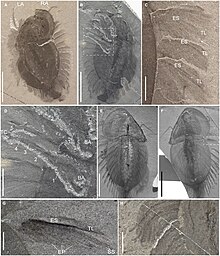
Trilobites are extinct marine arthropods that form the class Trilobita. Trilobites form one of the earliest known groups of arthropods. The first appearance of trilobites in the fossil record defines the base of the Atdabanian stage of the Early Cambrian period and they flourished throughout the lower Paleozoic before slipping into a long decline, when, during the Devonian, all trilobite orders except the Proetida died out. The last trilobites disappeared in the mass extinction at the end of the Permian about 251.9 million years ago. Trilobites were among the most successful of all early animals, existing in oceans for almost 270 million years, with over 22,000 species having been described.

Redlichiida is an order of trilobites, a group of extinct marine arthropods. Species assigned to the order Redlichiida are among the first trilobites to appear in the fossil record, about halfway during the Lower Cambrian. Due to the difficulty to relate sediments in different areas, there remains some discussion, but among the earliest are Fallotaspis, and Lemdadella, both belonging to this order. The first representatives of the orders Corynexochida and Ptychopariida also appear very early on and may prove to be even earlier than any redlichiid species. In terms of anatomical comparison, the earliest redlichiid species are probably ancestral to all other trilobite orders and share many primitive characters. The last redlichiid trilobites died out before the end of the Middle Cambrian.

Nektaspida is an extinct order of non-mineralised artiopodan arthropods. They are known from the mid-Cambrian to the upper Silurian. Originally classified as trilobites, which they superficially resemble, they are now placed as close relatives as members of the Trilobitomorpha within Artiopoda. The order is divided into three major families; Emucarididae, Liwiidae, and Naraoiidae.
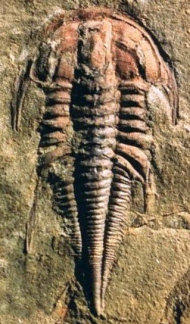
Emuellidae are a small family of trilobites, a group of extinct marine arthropods, that lived during the late Lower Cambrian of the East Gondwana supercontinent, in what are today South-Australia and Antarctica.

Olenoides was a trilobite from the Cambrian period. Its fossils are found well-preserved in the Burgess Shale in Canada. It grew up to 10 cm long.

Naraoia is a genus of small to average size marine arthropods within the family Naraoiidae, that lived from the early Cambrian to the late Silurian period. The species are characterized by a large alimentary system and sideways oriented antennas.

Misszhouia is a genus of small to average sized marine trilobite-like arthropods within the Naraoiidae family, that lived during the early Cambrian period. The species are M. longicaudata, from the Maotianshan Shales, described in 1985, and M. canadensis, from the Burgess Shale and described in 2018, although later species may belongs to genus Naraoia instead.
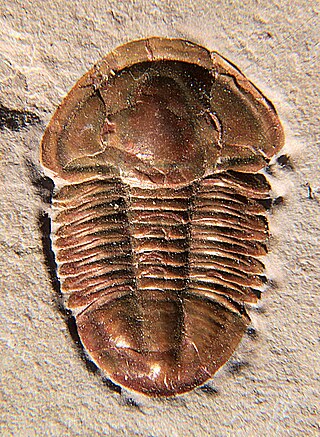
Asaphiscus is a genus of trilobite that lived in the Cambrian. Its remains have been found in Australia and North America, especially in Utah.

Panlongia was a small-sized marine arthropod, with an oval-shaped non-calcified exoskeleton. Both the head shield and the tail shield are semi-circular. In between the cephalon and pygidium are four thoracic body segments (somites). The cephalon occupies approximately ⅓ of the body length, the thorax ¼ and pygidium about 45%. Panlongia lived during the late Lower Cambrian (Botomian) in what is today South China. In Panlongia spinosa the edge of the exoskeleton carries several small sawtooth-like spines, that are absent in P. tetranodusa.

Eoredlichia is an extinct genus of trilobite of average to large size. It lived during the early Cambrian in the Chengjiang fauna of Yunnan, China, and in Australia and Thailand. Eoredlichia is compounded of the Greek ἠώς and Redlichia, a later but related genus, so it means "early Redlichia". The species epithet intermedia means intermediate, indicating it is morphologically intermediate between other species. Eofallotaspis gives rise to Lemdadella, and thence to Eoredlichia and the other Redlichiidae.

Aaveqaspis is a genus of small marine arthropods of unclear affiliation, that lived during the early Cambrian period. Fossil remains of Aaveqaspis were collected from the Lower Cambrian Sirius Passet fossil-Lagerstätte of North Greenland. Aaveqaspis looks like a soft eyeless trilobite with a weakly defined axis, a headshield with stubby genal spines, 5 thorax segments also ending in stubby genal spines, and a tailshield (pygidium) with a pair of massive tusk-like spines, and two smaller spines near the end of the axis. The only species presently known is A. inesoni.

Buenaspis is a genus of small nektaspid arthropod, that lived during the early Cambrian period. Fossil remains of Buenaspis were collected from the Lower Cambrian Sirius Passet Lagerstätte of North Greenland. Buenaspis looks like a soft eyeless trilobite. It has a headshield slightly larger than the tailshield (pygidium), and in between them six thoracic body segments (somites). The genus is monotypic, its sole species being Buenaspis forteyi.

Emucarididae is an extinct family of soft-shelled trilobite-like arthropods (nektaspids) from the Lower Cambrian of South Australia and South China. It contains only two genera – Emucaris and Kangacaris. Two species were described in 2010 from specimens recovered from Emu Bay Shale Lagerstätte, one species in 2012 from the Maotianshan Shales. It is classified under the order Nektaspida, and is a sister-group to the families Liwiidae and Naraoiidae.

Emucaris fava is an extinct species of soft-shelled trilobite-like arthropod of the nektaspid order from the Lower Cambrian of South Australia. It is the only species classified under the genus Emucaris.

Kangacaris is an extinct genus of soft-shelled trilobite-like arthropod of the nektaspid order from the Lower Cambrian (Botomian). K. zhangi is known from South Australia, and K. shui from South-West China.
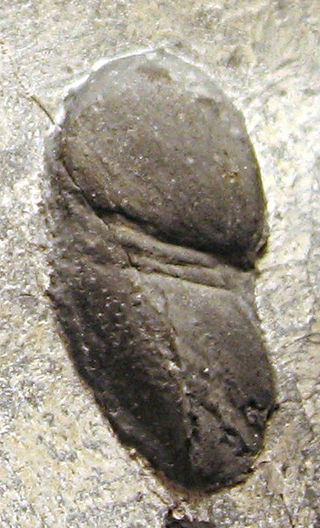
Tariccoia is a genus of nektaspid arthropods belonging to the family Liwiidae, known from fossils found in Ordovician strata in Sardinia and Morocco. It is between 2.5 centimetres (0.98 in) and 6 centimetres (2.4 in) long. It has a headshield wider than the tailshield (pygidium), and in between them three thoracic body segments (somites).
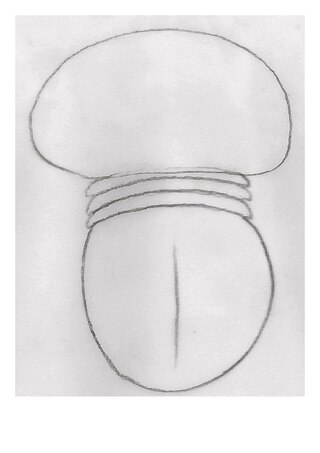
Soomaspis is a genus of small to average size marine arthropods in the Liwiidae Family, that lived during the late Ordovician. Fossil remains of Soomaspis were collected from the Soom Shale Lagerstätte in Western Cape, South Africa. Soomaspis looks like a large, soft agnostid trilobite. It has a headshield wider than the tailshield (pygidium), and in between them three thoracic body segments (somites). The genus is monotypic, its sole species being Soomaspis splendida.

Pseudonaraoia is a genus of small marine arthropods within the family Naraoiidae, that lived during the late Middle Ordovician period. The only species presently known is Pseudonaraoia hammanni.

Squamacula is an extinct artiopodan arthropod from the Cambrian Series 2. The type species S. clypeata was described in 1997 from the Chengjiang biota of Yunnan, China. At the time of description there were only two known specimens of S. clypeata, but now there are at least six known specimens. In 2012 a second species S. buckorum was described from the Emu Bay Shale of Australia.
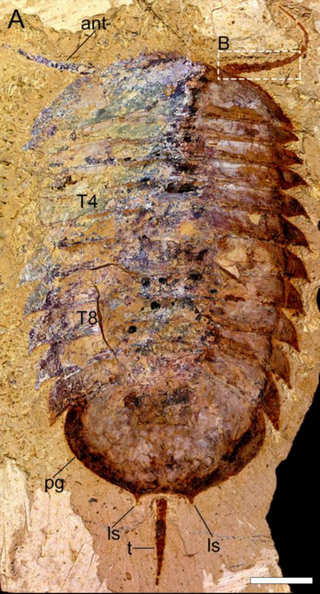
Retifacies abnormalis is an extinct arthropod that lived in the lower Cambrian. Its fossil remains have been found in the Maotianshan Shales of Yunnan, China. It is a member of the Artiopoda, and closely related to Pygmaclypeatus.

